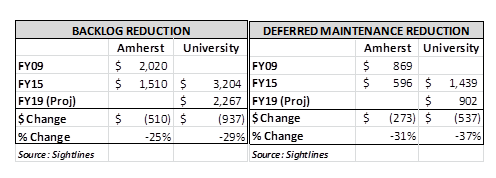UMass announces major progress on campus renovations
UMass doing "all the right things" expert says
BOSTON -- President Marty Meehan today said the University of Massachusetts now spends three out of four capital dollars on renovation and repair and has significantly reduced its maintenance backlog in recent years.
President Meehan, in a letter submitted to state government leaders, noted that UMass has gone through a building boom over the past 20 years - largely in response to enrollment and faculty-innovation booms - but said the university over the past decade has placed a significant emphasis on maintenance and renovation.
"The building that has taken place across the UMass system has been critical to our ability to step forward and emerge as a great public university. While we have constructed new facilities, we have also recognized the need to repair facilities that aged over the years," he said.
One of the fastest growing universities in the nation, the five-campus UMass system experienced a 44 percent surge in enrollment in the past two decades and built academic buildings and student housing to accommodate the increase of 22,000 students. It also constructed laboratories and other facilities needed as it emerged as a global research university.
But UMass also recognized that it had to repair as well as build, Meehan said, and has been guided in its efforts by Sightlines, a company that advises more than 400 colleges and universities across the nation and in Canada on facilities-management issues.
In his letter to state government leaders, President Meehan said recent reports from Sightlines show that:
- Between 2009 and 2015, UMass Amherst reduced its project Backlog from $2 billion to $1.5 billion, achieving a 25 percent decrease.
- UMass Amherst saw Deferred Maintenance decrease significantly during this period, declining from $869 million to $596 million, for an even larger percentage reduction of 31 percent. This occurred at a time when Backlog at public universities in the United States grew by nearly 20 percent, according to Sightlines.
- Sightlines calculates that the UMass System is on course to reduce its current $1.45 billion in Deferred Maintenance by nearly 40 percent to $900 million by Fiscal Year 2019, when the University's current Capital Plan concludes.
- It is also projected that the Backlog for the UMass System will decline from $3.2 billion to $2.26 billion over the next three years.

Backlog refers to those facilities projects that should be handled over the next decade, and Deferred Maintenance is the term for projects that need to be addressed within three years.
"We are not declaring victory or minimizing the work that lies ahead, but I think it's important to note that UMass has charted this prudent course," President Meehan said.
"The University of Massachusetts has taken the responsible course in addressing the needs of buildings that in some cases are 40-plus years old," said Victor Woolridge, chairman of the UMass Board of Trustees.
"We have taken on issues that we needed to confront in order to be able to provide really good students with the high-quality facilities they need to be able to compete in the contemporary environment," Chairman Woolridge added.
"On occasion, people ask me why UMass students need world-class facilities. And my answer always is: 'Because our students are world class,'" President Meehan said.
James Kadamus, vice president of Sightlines, said: "I think UMass is doing all the right things."
Other key points in President Meehan's letter:
- Nearly three-quarters of the current UMass capital program is dedicated to projects that will reduce the five-campus System's project Backlog.
- Since 2008, UMass has included a maintenance reserve for every new building constructed by the University.
- Enrollment at UMass has increased by 44.5 percent over the past 20 years, soaring from 51,044 to 73,761 students. Of the 22,717 students UMass has added, 14,673 are in-state students; out-of-state students increased by slightly more than 8,000.
President Meehan said: "We are pleased that students from other countries and states are choosing UMass, but we, of course, will always have a special commitment to Massachusetts students."
During the last two decades, UMass has expanded to meet the surge in demand for high-quality public higher education and has also become a key economic engine for the state. With more than $600 million in research expenditures, it is one of the top three research institutions in the Commonwealth, along with MIT and Harvard, and has expanded the innovation economy beyond the Boston corridor to central and western Massachusetts, and to the Merrimack Valley and the SouthCoast.
Contact: Robert P. Connolly, 617-287-7073